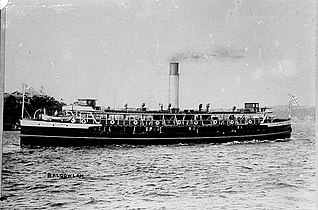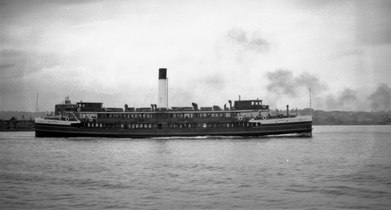SSBalgowlah
 BalgowlahonSydney Harbour
| |
| History | |
|---|---|
| Name | Balgowlah |
| Namesake | Balgowlah |
| Owner | Port Jackson & Manly Steamship Company |
| Operator | Port Jackson & Manly Steamship Company |
| Port of registry | Sydney |
| Route | Manly |
| Builder | Mort's Dock,Balmain |
| Cost | £26,000 |
| Yard number | 38 |
| Laid down | 1911 |
| Launched | 18 June 1912 |
| In service | 28 November 1912 |
| Out of service | 27 February 1951 |
| Identification | Official number131538[1] |
| Fate | Scuttled |
| General characteristics | |
| Class and type | Binngarraclass ferry |
| Tonnage | 499GRT |
| Length | 64.00 m (210 ft 0 in) |
| Beam | 10.00 m (33 ft) |
| Draught | 3.75 m (12 ft 4 in) |
| Decks | 2 |
| Speed | 15 kn (27.78 km/h) maximum speed |
| Capacity | 1,517 |
SSBalgowlahwas a ferry onSydney Harbouroperated by thePort Jackson & Manly Steamship Companyon theManly servicefrom 1912 until 1951.
Background
[edit]
The Port Jackson & Manly Steamship Company's fleet transitioned comparatively late to screw propelled vessels and the fleet comprised mostly paddle steamers until the early years of the twentieth century. The difficulty of turning in the narrow bays of Sydney Harbour - particularly in the busy Circular Quay terminus inSydney Cove- required the use of double-ended vessels. However, a double-ended screw configuration was particularly difficult for the fine bows that Manly ferries required for both speed and heavy seas. Further, a propeller at the leading forward end of a vessel reduced speed considerably. In the prosperous early twentieth century, this speed drawback was overcome by increasing engine size and power.
The first screw ferries on the Manly run were two innovativeWalter Reeks–designed vessels; theSS Manly(1896), andSS Kuring-gai(1901), which were to become the fore-runners of the "Binngarra-class" ferries. They both had highforecastlesat either to help her run through the deep-sea conditions across theSydney Heads.The steel-hulledKuring-gaiwas larger and she further refined the basic design to be similar to the subsequent and larger "Binngarra-class" vessels.ManlyandKuring-gaihad both, however, followed paddle steamer design with their bridges around the midships funnels. Whereas the "Binngarra-class" vessels would have their wheelhouses at either end of their promenade decks.
The "Binngarra-class "ferries,Binngarra(1905),Burra-Bra(1908),Bellubera(1910),Balgowlah(1912),Barrenjoey(1913), andBaragoola(1922), were designed byMort's Dock and Engineering,initially under the guidance of former chief draughtsman Andrew Christie. The first five were built at Mort'sWoolwichyard andBaragoolawas built at theBalmainyard. They were among the largest ships built in Australian yards at the time and, on the admission of Mort's executives, were built by the dock more for prestige than profit. Build costs were higher in Australia than in the United Kingdom, but this was offset by the cost of sailing them out to Australia.
Design and construction
[edit]Balgowlahwas built byMort's Dockat theirWoolwichyard for thePort Jackson & Manly Steamship Companyfor a cost of £29,000. Launched on 18 June 1912 and commissioned on 28 November 1912.[2][3][4]
Balgowlahwas nearly identical to theBelluberaandBarrenjoeyand ultimately was the last coal burner in the fleet. It was capable of carrying 1,517 passengers in the summer and 982 in the winter (the highest capacity of this class)[5]and made over 110,000 return trips toManlycovering about 715,000 nautical miles.[4][6][7]
Provided with atriple expansion steam enginegenerating 122 hp, it was capable of 16 knots, one of the fastest ferries on the run and able to make the run in 25 minutes compared to the 30 mins of other vessels.[7][8]
-
Under construction atMort's Dock,Woolwich,May 1912
-
Balgowlahin close to her as-built form
Operational history
[edit]Unlike some of its sister ships, it had a relatively uneventful life - shortly after going into service in 1912, it tangled with the collierFive Islandsand caught itself in that ship's anchor chain. No damage was done. In 1927, it collided withSydney Ferries Limited'sKanimblaatBennelong Point.Steel-hulledBalgowlahreceived minor damage, while timber-hulledKanimblahad a large gash torn in one side and came close to sinking. In 1929, it collided with the collierBirchrove Park,only minimal damage was done to both ships.[3]
It scraped into the Sydney Ferries Limited'sKangarooin 1913. Also in 1927, it collided with theUnion Steamship Company'sManuka,losing around 10 feet (3.0 m) of its sponson.[9]In 1939, it overshot the wharf atCircular Quayand went aground in soft mud. Although it ripped through the buffer stop, no damage was done. It took two tugs to pull it free.[3]
The exorbitant cost and difficulty in replacing the large expensive steel-hulledBinngarra-type vessels saw theBalgowlah,along with theBellubera,Barrenjoey,andBaragoolaretained and significantly modified. In the 1920s, all four had officers' cabins attached to their wheelhouses. Beginning withBarrenjoeyin 1930, and then in 1931-32Balgowlah,Baragoola,andBelluberaover 1931-32, had their open upper passenger decks enclosed.
In 1946, it was decided thatBalgowlahandBarrenjoeywould be converted to diesel power.Barrenjoeywas first, and re-emerged in 1951 asNorth Head.However,Balgowlahwas never converted, the cost of convertingNorth Headhad left the company in grave financial circumstances and it could not afford the cost of reconditioning the hull. The engines purchased for the conversion were later placed in theBaragoola.Balgowlahwas instead used as the company's relief vessel in the postwar years untilNorth Headreturned to service following her conversion to diesel.[10][11]It made its last trip on the 08:05 to Manly on 27 February 1951 and was then laid up.[3]
-
With extended wheelhouses and original open upper decks, ca 1930
-
1930s or 1940s after her upper decks were enclosed.
-
In World War II wartime grey, 1940s
-
Balgowlahcirca 1950 in her final configuration showing enclosed upper decks and fully extended wheelhouses.
Demise
[edit]
After being laid up since 1951, it was sold to Sylvester Stride,Leichhardtin 1953 for breaking up. The hull was cut down and converted to a lighter, and used in the demolition of the oldIron Cove Bridgeafter which it was allegedly scuttled nearby.[3][4][6]
See also
[edit]References
[edit]- ^crewlist.org.uk
- ^New Manly SteamerSydney Morning Herald19 June 1912 page 21
- ^abcdeSS BalgowlahFerries of Sydney
- ^abcManly Ferries Balgowlah, Barrenjoey & BaragoolaHistory Works December 2007
- ^Prescott, Anthony (1984).Sydney Ferry Fleets.Ronald H Parsons.ISBN978-0-909418-30-4.
- ^abMead, Tom (1988).Manly Ferries of Sydney Harbour.Brookvale: Child & Associates. p. 164.ISBN0 86777 091 0.
- ^abAndrews, Graeme (1975).The Ferries of Sydney.A.H. & A.W. Reed Pty Ltd. p. 47.ISBN0589071726.
- ^Prescott, AM (1984).Sydney Ferry Fleet.Magill South Australia: Ronald H Parsons. p. 58.ISBN0909418306.
- ^Collision in HarbourSydney Morning Herald26 April 1921 page 6
- ^City of Sydney archives
- ^City of Sydney archives
External links
[edit] Media related toBalgowlah (ferry, 1912)at Wikimedia Commons
Media related toBalgowlah (ferry, 1912)at Wikimedia Commons






